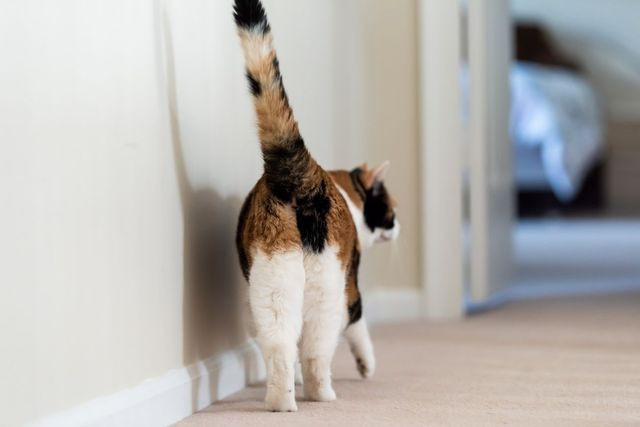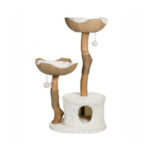 A cat walking away down a hall
A cat walking away down a hall
As a cat owner, you might be familiar with the occasional peculiar smells your feline friend emits. One source of these odors, and a crucial part of feline anatomy, is the anal glands. But Do Cats Have Anal Glands, and what is their purpose? Yes, cats do have anal glands, also known as anal sacs, and they play a significant role in your cat’s health and behavior. These small sacs, located on either side of the anus, secrete a fluid with a strong, musky odor. While they function normally in most cases, anal glands can sometimes become problematic, leading to discomfort and health issues for your beloved pet. Understanding these glands, their function, and potential problems is essential for responsible cat ownership.
This article will delve into the world of feline anal glands, covering:
- The function of feline anal glands.
- Recognizing the symptoms of anal gland disease in cats.
- Different types of anal gland issues cats can experience.
- How anal gland disease is diagnosed and treated by veterinarians.
Veterinary professionals diagnose anal gland problems through physical examinations, including rectal exams, and sometimes additional tests like biopsies or bacterial cultures. Treatment approaches vary depending on the specific condition, ranging from antibiotics and anti-inflammatory medications to surgery and, in rare cases, oncology referrals. Fortunately, the majority of anal sac issues in cats are non-cancerous and can be managed effectively with proper veterinary care.
What are Feline Anal Glands?
Feline anal glands, often referred to interchangeably as anal sacs, are small pouch-like structures situated between the muscles of the rectum and on either side of the anus. These glands are lined with cells that produce a viscous, foul-smelling secretion. This fluid is stored within the sacs and is typically expelled during defecation. The terms “anal glands” and “anal sacs” are commonly used to describe the same anatomical structures, reflecting both the glandular tissue and the sac-like reservoir that holds the secretions.
The primary function of this pungent fluid is believed to be for territorial marking and communication. Each cat’s anal gland secretion has a unique scent profile, acting like a feline fingerprint. When a cat defecates, the pressure helps express a small amount of this fluid, leaving behind a scent marker that communicates information to other cats in the vicinity. This scent marking behavior is a natural form of feline communication, contributing to their complex social interactions. Anal gland secretions can also be released when a cat is frightened or stressed, serving as an additional defense mechanism or communication signal in stressful situations.
However, when these anal sacs malfunction, various diseases can arise, ranging from impaction and infection to more serious conditions like rupture and even cancer. Understanding the normal function of these glands makes it easier to recognize when something is amiss and to seek timely veterinary care for your cat.
Recognizing the Clinical Signs of Anal Gland Disease in Cats
Various conditions can affect a cat’s anal sacs, and many share overlapping symptoms. Recognizing these signs of anal gland disease is crucial for early intervention and treatment. While not every cat will exhibit all symptoms, and symptom severity can vary, common indicators of an anal gland disorder include:
- Foul Odor: A persistent, unpleasant smell, often described as fishy or musky, emanating from the rear end of your cat is a key indicator. This odor may be noticeable around your cat or in areas where they have been sitting or lying.
- Anal Scooting: This is a classic sign where cats drag their rear end along the floor, often in an attempt to relieve itching or irritation caused by inflamed or full anal glands.
- Discomfort or Reluctance to Sit: Cats experiencing anal gland issues may show signs of discomfort when sitting, such as shifting positions frequently, sitting lopsided, or avoiding sitting altogether. They might also show hesitation when being picked up around their rear end.
- Redness and Swelling Around the Anus: Visible inflammation, redness, or swelling in the perianal area can indicate an anal gland problem, such as infection or impaction.
- Excessive Grooming or Biting at the Base of the Tail or Anus: Increased attention to the anal area, including excessive licking, chewing, or biting at the base of the tail or around the anus, suggests irritation and discomfort.
- Open Sores or Drainage Around the Anus: In cases of ruptured anal glands, open sores, wounds, or draining tracts may be visible near the anus.
- Constipation or Straining to Defecate: While less common, anal gland issues can sometimes contribute to constipation or difficulty passing stool due to pain or obstruction.
- Blood on Stool: Small amounts of blood, particularly bright red blood, on the surface of the stool or in the litter box can be a sign of anal gland inflammation or rupture.
- Painful Defecation or Vocalization During Defecation: If your cat cries out or shows signs of pain while defecating, it could indicate anal gland discomfort.
It’s important to remember that the mere presence of anal gland fluid odor doesn’t automatically indicate a problem. Anal glands naturally express small amounts of fluid periodically, especially when a cat is startled or stressed. The distinctive smell can linger. However, if you observe any of the above symptoms in conjunction with a persistent odor, it’s important to consult with a veterinarian to determine if your cat is experiencing an anal gland issue. Early detection and intervention are key to preventing complications and ensuring your cat’s comfort and well-being.
Types of Anal Sac Diseases in Cats
Anal sac diseases in cats encompass a range of conditions affecting these glands. These conditions are often interconnected and vary in severity and prevalence. Understanding the different types of anal gland issues can help cat owners be more informed and proactive in seeking appropriate veterinary care.
Anal Sac Impaction
Anal sac impaction is the most common anal gland disorder in cats. It occurs when the anal gland secretions become thickened and cannot be expelled normally during defecation. This leads to a buildup of fluid within the sacs, causing them to become distended and firm. Cat owners might notice enlarged glands as firm swellings on either side of the anus. Affected cats often exhibit irritation, scooting, and discomfort in the perianal area. Factors contributing to impaction can include soft stools, obesity, and reduced muscle tone in the area.
Anal Gland Rupture
Anal gland rupture is a more severe consequence of untreated impaction. When the ducts of the anal glands become blocked, or the accumulated fluid becomes excessively thick, pressure builds up within the impacted sac. This pressure can eventually lead to the skin overlying the gland thinning and rupturing. A ruptured anal gland presents as an open, inflamed, and draining wound near the anus. This condition is painful and requires veterinary attention to clean the wound, manage infection, and address the underlying cause.
Anal Gland Infection (Anal Sacculitis)
Anal gland infection, also known as anal sacculitis, occurs when bacteria proliferate within the anal sacs. Infections are often secondary to impactions or ruptures, as the stagnant fluid and open wounds create an environment conducive to bacterial growth. An anal sac abscess develops when a localized pocket of pus forms around the infected gland. Cats with infected anal glands typically display more pronounced pain compared to those with simple impactions. Distinguishing between impaction and infection can be challenging based on symptoms alone, but both conditions necessitate veterinary treatment, often involving antibiotics and gland flushing.
Anal Gland Cancer (Anal Sac Adenocarcinoma)
While less common than other anal gland issues, anal gland cancer, specifically anal sac adenocarcinoma, is a serious concern. Adenocarcinoma is a malignant tumor originating from glandular tissue. Although adenocarcinoma is a relatively common cancer type in other parts of the body, anal gland cancer is considered rare in cats. Anal sac adenocarcinomas are aggressive malignancies that can spread (metastasize) to other parts of the body, such as regional lymph nodes, lungs, and bones, before diagnosis. Recurrence after treatment is also common. Early detection is critical, but differentiating tumors from other anal gland conditions based on physical examination alone can be difficult, especially when infection or rupture is present.
Diagnosing Anal Sac Disease in Cats
A comprehensive veterinary examination, including a rectal exam, is essential for diagnosing anal sac disease in cats. During a rectal examination, the veterinarian will palpate the anal sacs to assess their size, consistency, and pain level. In cats with anal sac disease, the glands may feel enlarged, firm, and painful upon palpation. Visual inspection of the perianal area may reveal additional clinical signs such as swelling, redness, or open sores indicative of rupture or infection.
However, it can be challenging to definitively rule out anal gland tumors solely based on a physical exam, particularly when significant tissue alteration is present due to abscesses, impactions, ruptures, or combinations of these issues. Since anal gland disease can sometimes be secondary to underlying health problems, especially conditions causing abnormal stool consistency (either very loose or very firm), further diagnostic testing may be recommended to identify concurrent health issues or to rule out anal gland cancer.
Additional diagnostic tests may include:
- Blood Tests: To assess overall health and screen for systemic illness.
- Fecal Tests: To rule out intestinal parasites or evaluate digestive health.
- Culture of Gland Secretions: To identify specific bacteria involved in anal gland infections and guide antibiotic selection.
- Anal Gland Biopsy: A tissue sample taken from the anal gland for microscopic examination to diagnose cancer or other tissue abnormalities.
- Imaging (X-rays, Ultrasound, CT Scan): To assess for tumor spread (metastasis) or to evaluate other abdominal organs if underlying systemic disease is suspected.
Once the type and severity of the anal gland disorder are determined through these diagnostic steps, a targeted and effective treatment plan can be developed to address the specific needs of the cat.
Treatment Options for Anal Sac Disorders in Cats
Treatment for anal sac disorders in cats is tailored to the specific diagnosis and severity of the condition. Medical treatment options are often effective for managing less severe cases, while more advanced or recurrent issues may require surgical intervention.
Common medical treatments include:
- Manual Expression of Anal Glands: This procedure involves the veterinarian gently squeezing the anal sacs to express the accumulated fluid. This can provide immediate relief for impacted glands.
- Lancing and Draining Abscesses: For anal gland abscesses, the veterinarian may need to lance (surgically open) and drain the pus pocket.
- Flushing Glands and Infusing Antibiotics: After expression or drainage, the anal sacs may be flushed with antiseptic solutions and infused with topical antibiotics or anti-inflammatory medications to treat infection and reduce inflammation.
- Systemic Antibiotics, Steroids, or Pain Medications: Oral or injectable antibiotics are prescribed to combat bacterial infections. Steroids (anti-inflammatory drugs) can help reduce swelling and pain. Pain medications are used to manage discomfort, particularly in cases of infection or rupture.
- Surgery: Surgical removal of the anal glands (anal sacculectomy) is reserved for severe, recurrent cases that do not respond to medical management, or for the treatment of anal gland tumors.
Dr. Jo Myers, a veterinarian on the Vetster platform, emphasizes the importance of addressing underlying causes: “Management of the underlying cause of the anal gland issue is also necessary for overall treatment. Obesity, frequent diarrhea from inflammatory bowel disease, and dehydration from chronic kidney disease can negatively affect normal anal gland function.” Cats with a history of anal gland problems are prone to recurrence, making long-term management of underlying conditions crucial.
Surgical removal of the anal sacs is a more invasive procedure and carries potential risks, such as fecal incontinence. However, it may be the only curative option for cancerous anal sac tumors. While chemotherapy and radiation therapy may be considered for anal gland cancer, the prognosis is often guarded, especially if metastasis has occurred.
Does My Cat Need Their Anal Glands Expressed Regularly?
Healthy anal glands typically express naturally during defecation and do not require routine manual expression. In fact, frequent, unnecessary expression can potentially cause irritation. Manual expression should only be performed when medically indicated and ideally by a veterinary professional. Attempting to express your cat’s anal glands at home can be risky if not done correctly and may worsen the problem or cause injury to your cat.
Cats who experience recurrent anal gland impactions may require periodic manual expression, but this should always be under the guidance and recommendation of a veterinarian. Furthermore, identifying and treating the underlying cause of recurrent impactions is essential for long-term management rather than relying solely on repeated expressions.
What to Do if Your Cat Shows Symptoms of Anal Gland Issues
If you observe any symptoms of anal gland issues in your cat, such as scooting, foul odor, swelling, redness, or excessive grooming of the anal area, it is crucial to consult with a veterinarian. Always seek professional veterinary advice before attempting any home remedies or manual expression, as this could be harmful or delay appropriate treatment.
Other medical conditions, such as intestinal parasites, allergies, or dietary sensitivities, can also cause similar symptoms, so a veterinary diagnosis is necessary to determine the underlying cause and receive appropriate treatment. If your cat has a history of anal gland problems, discussing long-term management strategies with your veterinarian is essential to prevent recurrence and maintain your cat’s quality of life.
For prompt advice and guidance, consider connecting with a veterinarian through a virtual vet appointment platform like Vetster if you are concerned about your cat’s anal gland health.
FAQ – Understanding Cat Anal Gland Issues
How Do You Know if Your Cat Needs Anal Gland Expression?
Cats with healthy anal sacs do not require manual expression. Signs that your cat might need anal gland expression (and veterinary attention) include: swelling, redness, tenderness around the anus, scooting, excessive licking or biting at the anal area, and discomfort when sitting. Attempting to express your cat’s glands at home can be dangerous and potentially worsen their condition. It is best to have a veterinary professional assess and perform gland expression if necessary.
Should I Worry if My Cat is Scooting?
Yes, scooting is a sign that your cat is experiencing anal irritation. While it can be caused by various issues like allergies, fleas, or dietary sensitivities, scooting is a common symptom of anal sac disease. If your cat is scooting, it’s important to consult a veterinarian to get a definitive diagnosis and appropriate treatment plan.
What Does Anal Gland Cancer Look Like in Cats?
Anal gland cancer in cats, most commonly anal sac adenocarcinoma, may not have a distinct appearance readily visible to the naked eye. Often, the only noticeable sign is swelling in the anal gland area. It can be difficult to differentiate between enlarged glands due to impaction, infection, or a tumor without further diagnostic tests. Veterinary examination and potentially biopsy are necessary to confirm a diagnosis of anal gland cancer.
 New Puppy Guide: A companion resource for your dog’s first year of life – A small white puppy galivanting through a field
New Puppy Guide: A companion resource for your dog’s first year of life – A small white puppy galivanting through a field
Related Posts:
New Puppy Guide: A companion resource for your dog’s first year of life
What to do if my dog has arthritis – An older-looking small dog walking on the sidewalk, with out-of-focus fallen leaves in the foreground.
What to do if my dog has arthritis
What to do if my puppy’s eyes suddenly get cloudy – Golden puppy runs along the beach during fog
What to do if my puppy’s eyes suddenly get cloudy

